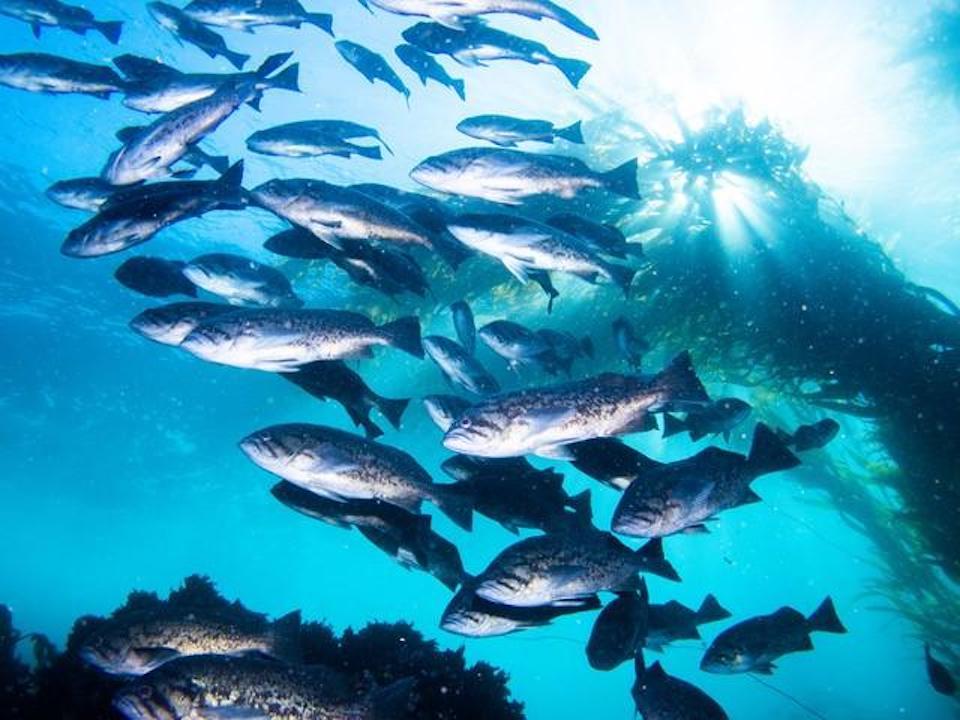
A school of Blue rockfish in marine protected areas near Channel Islands National Park/Katie Davis
While poaching continues to be a problem at some units of the National Park System, off the coast of California poaching isn't an issue and the fisheries are thriving in marine protected areas around Channel Islands National Park, according to an analysis by an Oregon State University researcher.
The analysis estimates fish populations and harvest rates based on the numbers of larger, older fish present; fewer larger fish indicates higher harvesting rates. Researchers found harvest rates essentially at zero for four species of kelp forest fish inside the marine protected areas between 2003 and 2017, but found much higher rates of harvesting at unprotected sites nearby.
"We expected we would find more large fish in the marine protected areas, and that is exactly what happened," said Will White, a marine ecologist with Oregon State's Coastal Oregon Marine Experiment Station in Newport and the paper's lead author. "We looked at the data inside and outside the marine protected areas and we found that there is no evidence of fishing inside the boundaries, but there is a lot of fishing going on just outside the boundaries."
The study is believed to be the first to directly assess whether marine protected areas have eliminated harvesting of fish inside their boundaries, said White, who is also an assistant professor in the OSU College of Agricultural Sciences' Department of Fisheries and Wildlife.
The findings were published in the journal Conservation Letters. Co-authors include Mark Yamane, an undergraduate student participating in a National Science Foundation-sponsored research experience at Hatfield Marine Science Center; Kerry Nickols of California State University, Northridge; and Jennifer Caselle of the University of California, Santa Barbara. The research was supported by the National Science Foundation and the David and Lucile Packard Foundation.
The state of California first established a network of 13 marine protected areas around the northern Channel Islands off the coast of southern California in 2003.
Marine protected areas that restrict or prohibit the harvest of wild populations of fish or other sea life are seen as a way to help replenish populations that have been overfished. They are an increasingly popular tool for fisheries management around the United States and throughout the world.
The assumption is that harvesting ceases in the protected areas, but determining if or how much illegal harvesting, or poaching, is occurring has been a challenge for researchers, which led White to develop a new method for analyzing fish populations.
The Partnership for Interdisciplinary Studies of Coastal Oceans, or PISCO, has been conducting long-term surveys of kelp forests along the West Coast for more than 20 years. PISCO researchers surveyed fish populations throughout the Channel Islands, both inside and outside the current marine protected areas, each year from 1999 through 2017.
White used that repository of data to develop the new analysis, which estimates harvest rates based on the number of larger, older fish present at a given time. The researchers were able to compare fish populations of four species of kelp forest fish year-over-year after the marine protected areas were in place.
The researchers found that overall, the harvest rates of fish in the protected areas were essentially at zero, indicating that fishing has ceased in the protected areas. Two locations showed a low harvest rate, suggesting some poaching may be occurring or that the fish in those areas may be straying outside protected boundaries, which is the more likely scenario, White said.
"In an unfished population, you'd expect to have lots of little fish, some medium fish and some really big fish. In a heavily fished area, you would have little fish and some medium fish, but not many big fish," he said. "The question is, 'Do these look like unfished populations?' and the answer is, they do."
However, in some locations outside the marine protected areas, harvest rates are much higher than expected, possibly because there is more fishing there since the marine protected areas were established. Those shifts in fishing behavior are something fisheries managers and policymakers would want to consider, as well.
"People are fishing where they are supposed to," White said, "but that may have additional repercussions."
The new analysis could be a useful tool for understanding the effectiveness of marine protected areas at a time when fisheries management officials in California and Oregon are preparing to embark on evaluations of their programs, White said. The state of California is expected to begin its review in 2022 and Oregon in 2023.



Add comment